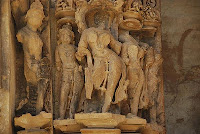The area that constitutes the present day state of Maharashtra was the scene of the flourishing of many dynasties. After coming into the control of the Mauryan Empire, Satavahana kingdom held its sway over the territory. Junnar, thirty miles north of Pune, was the capital of the Satavahanas at one point of time.
During the Satavahana period, Maharashtra became a great centre of culture and learning. The official language of Satavahana was Maharashtri, which later developed into Marathi. The greatest ruler of the Satavahana dynasty was Gautamiputra Satkarni, who took pride in calling himself the destroyer of the Sakas (Scythians), Yavanas (Greeks) and Pahlavas (Parthians). He is credited to have started the Shalivahana era, a new calendar, still used by the Maharashtrians. Sri Yajna Satkarni was the last great king of the Satavahana kingdom. According to some Puranas, 19 kings of this dynasty ruled for 300 years, while according to others, 30 kings ruled for 465 years. The dynasty came to an end about the middle of the third century A.D.
After the fall of the Satavahana dynasty, the eastern part of Maharashtra came under the control of Vakatakas. Among other dynasties that ruled over the territory the Rashtrakutas, and the Yadavas of Deogiri find special mention.
The invading armies of the Delhi Sultanate rulers Ala-ud-din Khalji, and later Muhammad bin Tughluq took control of the territory of Maharashtra. After the collapse of the Delhi Sultanate, the area became part of the Bahmani Sultanate.
The greatest name in the history of Maharashtra was that of Shivaji who by dint of his hard work and sheer tenacity succeeded in creating a kingdom covering most of Maharashtra and nearly half of India in a short span of his life. He was the nemesis of Aurangzeb, the sixth Mughal emperor. Shivaji was born in the fort of Shivaner in 1627 and deied on April, 1680.
Shivaji's death was followed by internal dissensions in the newly created Maratha Kingdom. There was a dispute about succession between the two sons of Shivaji. Finally Sambhaji ascended the throne in 1680. He was captured, and after cruel torture for more than three weeks, he was brutally put to death by Aurangzeb.
Rajaram's nephew & Sambhaji's son, Shahu Bhosale (born May 18, 1682) who had been in Mughal captivity since November 3, 1689, was liberated on May 8, 1707. He was recognized as the king of the Marathas. This was resented by Rajaram’s wife Tara Bai. However, Shahu ultimately came out victorious, manly with the help and advice of a Chitpavan Brahmana from Konkan, named Balaji Viswanath.
Balaji’s character and capacity and the peculiar circumstances of the country favoured the rise of the Peshwas to power and renown. He has been rightly called the second founder of the Maratha state.
After the death of Balaji Viswanath, his eldest son Bajiroa, a young man of hardly twenty, was appointed the Peshwa by Sahu. Under him the Maratha power reached its zenith.
Maharashtra played an important role in India’s freedom struggle. Bal Gangadhar Tilak, Mahadev Govind Ranade, Gopal Krishna Gokhale, Vinayak Damodar Savarkar, Pherozeshah Mehta and Dadabhai Naoroji were some of the prominent leaders of the freedom struggle.
Maharashtra became a full fledged state on May 1, 1960, when Bombay Presidency State was bifurcated into the new linguistic states of Gujarat and Maharashtra.





